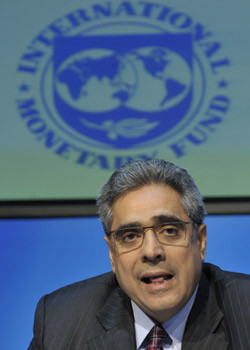Default and devalue

The only way out of the country’s economic black hole is to cut our losses and default on our debts, says Dan White
15 December 2010
The €85bn IMF bailout and the government’s four-year plan to take €15bn out of the economy won’t solve Ireland’s financial crisis. Instead, by doubling the national debt, Ireland’s banking crisis has been temporarily solved at the cost of an eventual default on the national debt and our expulsion from the euro.
When, at the end of September, the government announced that the cost of fixing Ireland’s banks would be €50bn, with €34bn going to Anglo alone, the New York Times ran an article wondering if one bank, Anglo Irish, could bring down a country.
Less than two months later we had our answer. When Ireland was finally forced to concede that it would apply for an EU/IMF bailout on 21 November it was clear that our delinquent banks had effectively bankrupted the country.
Bailout blues
With the capital markets closed to them, the Irish-owned banks had borrowed €90bn from the ECB and a further €34bn from our own Central Bank, before Frankfurt finally called a halt and insisted that the Irish government seek a bailout from the European Financial Stabilisation Fund, the joint venture between the EU and the IMF established to bail out Greece last May.
There is no denying that the Irish banks are in a truly shocking state. AIB announced on 19 November that it had lost €13bn of its deposits, a sixth of the total, so far this year, while Bank of Ireland revealed a week earlier that it had lost €10bn of deposits. What this demonstrated was that corporate depositors were losing faith in the Irish banks and withdrawing their money.
Something clearly had to be done to avoid a “run” on the Irish banks. That something was the EU/IMF bailout. In return for the Irish government agreeing to public spending cuts and tax increases of €15bn over the next four years, of which €6bn will be front-loaded in 2011, the EU and the IMF agreed to lend the Irish banks up to €67.5bn, not the €85bn figure which was widely trumpeted in media reports, with the remaining €17.5bn coming from the National Pension Reserve Fund and the government’s cash balances.
Government being overly optimistic?
So far so good, but will the cure turn out to be worse than the disease? Some of the projections upon which the government’s four-year budget plans are based strike me as being hopelessly optimistic. Under the plan the government forecasts that tax revenues will rise from €31.5bn in 2010 to €42.2bn in 2014, a cumulative 34% increase.
Fuelling this projected rise in tax revenues will be a return to strong economic growth with the government pencilling in 1.8% GDP growth in 2011, 3.3% in 2012, 3% in 2013 and 2.8% in 2013. If we accept the government’s forecasts then real GDP will be 11% bigger at the end of 2014 than it is now while nominal GDP, real GDP growth plus inflation, will be more than 16% larger.
In your dreams Brian Lenihan.
Country to receive fiscal shock
The four-year plan will deliver a contra-cyclical fiscal shock to the economy equivalent to that which has already been inflicted by the October 2008, April 2009 and December 2009 budgets. To predict what might happen if the four-year plan is fully implemented it is instructive to see what happened in the aftermath of those three budgets.
In 2009 the Irish economy as measured by GDP fell by 7% in real terms while GNP, which excludes multinational profits fell by a much larger 11.3%. And the economy kept shrinking in 2010 with the Central Bank forecasting that real GDP will grow by just 0.2% this year with GNP shrinking by a further 1.7% bringing the cumulative fall in real GDP to almost 7% and GNP to 13%.
When the deflation of the past two years is taken into account, nominal GDP has fallen by 14% and nominal GNP by 19%. That’s not a recession, more like a full-blown, 1930s-style depression.
So if the same medicine has already produced these disastrous results what are the chances of a repeat dose delivering almost exactly the opposite result? I suppose it might be theoretically possible but I wouldn’t care to bet on it.
Treading water
Far more likely is that the Irish economy will at best tread water and possibly shrink even further over the next four years – the ink was barely dry on the four-year plan when the EU Commission predicted that Irish GDP would grow by just 0.9% in 2011 and by 1.9% in 2012. If that turns out to be the case then the government’s tax projections could turn out to be hopelessly optimistic, no matter how many new taxes are introduced and existing ones raised.
This in turn has serious implications for our ability to repay the extra debt we will incur as a result of the EU/IMF bailout package. Assuming the full amount is drawn down our national debt will almost double to nearly €200bn over the next three years. The extra interest on this higher level of debt will gobble up a large chunk of the budget savings forecast by the government.
Bank loans will never be repaid
A higher interest bill is only one of the problems resulting from the bailout. Far more serious is the fact that it does nothing to address the key problems facing the Irish economy namely that the Irish banks have up to €200bn of loans on their books which will never be fully repaid. The bailout makes no provision for an orderly write-down of these bad debts.
In fact by underwriting a recapitalisation of the Irish banks the bailout facilitates the effective transformation of the banks’ bad loans into Irish sovereign debt. This means that while the German, British and French banks which lent so recklessly to the Irish banks get repaid in full, Irish taxpayers get landed with a huge liability.
Looked at in this light the EU/IMF package looks less and less like a bailout for Ireland and more lke one for the overseas banks.
Will state ever repay debt?
In reality, while the bailout may go some way towards solving the problems of the Irish banks, it has done so by creating another, potentially even more serious problem, this being that the Irish state will never be able to re-pay a near €200bn national debt. Meanwhile the interest costs of €10bn-€12bn a year will devour between a quarter and a third of total tax revenues.
This means that, at some stage over the next few years, particularly if the economic growth being forecast in the four year plan fails to materialise, Ireland will have no choice but to default on its debts. The fact that yields on Irish bonds actually rose, i.e. bond prices fell, following the announcement that Ireland was to seek a bailout demonstrated that the bond markets also believe that Ireland will default.
This growing realisation that, bailout or no, Ireland will almost certainly have to default in a few years time, means that Ireland’s membership of the euro, previously the most sacred of sacred cows, is also going to become a live political issue. If, despite the pain which accepting the bailout will most certainly entail, there is no improvement in our economic situation, then what’s the point of the euro?
Default before eviction
For Ireland euro membership is looking less and less attractive. It traps us in a straitjacket that makes economic recovery impossible. The disadvantages are increasingly coming to outnumber the advantages. With eventual debt default and expulsion from the euro now looking inevitable, why not get it over with now and at least give us some hope of economic recovery over the next few years? By far the least bad option currently facing us is to default and devalue now.



 Print
Print






Fans 0
Followers